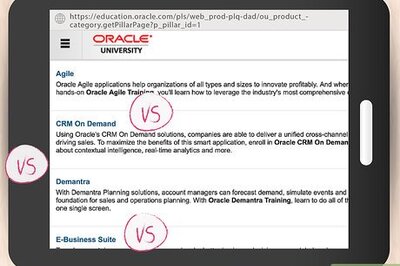
views
Recommended Daily Mileage for Runners
There’s no “best” distance to run per day, but here are some guidelines. Each person’s body is different, and the ideal number of miles to run per day depends on factors like your current fitness level (does running a mile feel easy, or can you barely make it around the block?), your running goals (are you training for a 5K, a marathon, or nothing at all?), and what other exercises you do (do you do other cardio that works your legs, like the elliptical or cycling? Are you mainly a lifter who wants to add more cardio?). However, if running is your main focus, here are the recommended mileages per day and week, broken down by experience level: Beginners: Aim for 5 to 8 miles (8 to 12.9km) per week, spread across 3 runs. This comes out to 1 to 3 miles (1.6 to 4.8km) per running day. Intermediate runners: Aim for 10 to 15 miles (16.1 to 24.1km) per week spread over at least 3 runs. This comes out to about 3 to 5 miles (4.8 to 8km) per running day. Advanced runners (half or full marathon training): Shoot for 20 to 25 miles (32.2 to 40.2km) per week for half marathon training or 25 to 30 miles (40.2 to 48.3km) per week spread over 4 to 5 runs. This typically works out to at least 6 miles (9.7km) per run, depending on your exact goals, with one extra long run per week. Recreational runners: If you’re running for fun or for your overall health, worry less about distance and more about time. Aim to run for 20 to 30 minutes, several times a week for the best cardiovascular and metabolic benefits.
Running for Weight Loss
It takes about 35 miles of walking or jogging to burn 1 pound of fat. A pound of fat is 3,500 calories, and the average person burns about 100 calories when they briskly walk or jog for a mile (although the exact amount depends on how much you weigh and how fast you’re going). This means that if you change nothing else about your lifestyle (no dieting or doing other exercise), you’d need to jog 35 miles to lose 1 pound. This means that if you ran 2 to 3 miles (3.2 to 4.8km) every day, you’d lose a pound after about 2 weeks. Want to lose weight faster? Reduce your daily calorie count in addition to running or walking. For example, if you eat 250 fewer calories a day and walk for 30 minutes a day (about 1.5 miles or so), it would take slightly over a week to lose a pound.
Daily Mileage for Longevity
One mile a day can have big impacts on your overall health and longevity. You don’t need to run as much per day to live longer than you might think. According to recent research, running just 5 to 10 minutes a day (even at a slow pace like 6 miles per hour, or a 10-minute mile) can reduce your risk of heart attack or stroke by 45% and your risk of dying from anything by 30%. These findings apply to just about anyone, regardless of weight, gender, age, and other health risk variables like high blood pressure, diabetes, smoking, or drinking. The longevity benefits of running plateau at about 4.5 hours per week (it won’t hurt your lifespan to run longer, though!). In general, the American Heart Association recommends getting 150 minutes of moderate aerobic activity (like running) or 75 minutes of vigorous aerobic activity per week, spread across several days.
Running for Mental Health
Try 90 minutes a week to improve mental health, but any amount can help. In a 2023 study, participants with depression or anxiety who ran for 30 minutes at a time, 2 to 3 times a week for 16 weeks, showed similar mental health improvements compared to a group taking antidepressant medication instead of running during the same time period. So, if you want to use running to clear your mind or boost your mood, aim to run for about a half hour a few times a week (the time is more important than the distance you cover). If conditions like depression are making it hard to get motivated to run, just do whatever amount you can. Even just a jog around the block can give you an endorphin boost, help get you on a running schedule, and make you feel satisfied for getting outside and accomplishing something. Important: Running and exercise are important to your overall mental health, but shouldn’t be used as a substitute for medication or therapy without the guidance of a healthcare professional. Speak to your doctor or mental health provider about how running can supplement other treatments, particularly if you’re struggling with conditions like depression, anxiety, and more.
Getting Started & Increasing Mileage as a Beginner
Start with whatever amount of running you can do (no matter how small). Where you begin depends on your fitness level—you can’t suddenly run 10 miles per week if 1 mile makes you wheeze. So, pick whatever amount (miles or minutes) you can realistically, consistently do each week and start from there. Maybe that’s a mile every other day, or maybe it’s just 20 minutes at a time, twice a week. There are no wrong answers! Don’t be afraid to combine running and walking at first. For example, you could run for 3 minutes and walk for 1 minute, then repeat that cycle several times to make up one workout. Leave at least 1 rest day (a day where you don’t run or do another aerobic activity) between runs when you’re first starting out. If you try to run too much too soon, you could risk getting sore, injuring yourself, or just burning out on running altogether.
Gradually increase your number of miles by about 10% per week. Slow and gradual increases help your body adjust to longer distances without overexertion or injury. Apply the 10% rule to your mileage or your overall time. For example, if you did four 1-mile runes last week, aim for four 1.1 miles runs this week. Or, if you ran for 20 minutes twice last week, try running for 22 minutes twice this week. To build endurance, Ng recommends “consistently increasing the time spent on your feet, or the distance you’re running.”
Slow down and improve your “easy running” to build stamina. You may be tempted to add more miles by simply running faster, but this won’t increase your endurance over time. Ng advises to “teach yourself to run in an aerobic state. If your [heart] is constantly working at 170 beats per minute (an anaerobic state), your aerobic system is not going to improve. Aim for anything less than 150 beats per minute to run in the [aerobic] zone. Your body can start burning fat versus carbs and create more red blood cells. That is all very helpful for endurance athletes, or a person that is trying to increase their endurance.” To track your heart rate while you run, wear a heart rate monitor strap or smartwatch that syncs with an app on your phone.
Running Plans for Race Training
5K A 5K (3.1 mile) race is a great goal for beginners, and you can train for one in about 2 months if you’re totally new to running (or less if you’re more experienced). Here’s a sample training plan—feel free to adapt the length or number of runs to suit your needs: Begin training about 7 weeks before the 5K. Structure each week like this: Monday and Wednesday: Run/walk for 30 minutes. Tuesday and Thursday: Walk for 30 minutes. Friday and Sunday: Rest or take a leisurely walk. Saturdays: Do a long run/walk. Increase your Saturday long run/walk throughout the 7 weeks: Week 1: 3 miles Week 2: 3.5 miles Week 3: 2 miles (push yourself to run/walk slightly faster) Week 4: 4 miles Week 5: 2 miles Week 6: 4.5 miles Week 7: 3.1 miles (race day)
Half marathon Assuming you’re at least an intermediate runner, it’s possible to train for a half marathon in about 8 weeks (but it will take longer if you’re a beginner). Keep the 10% rule in mind to gradually increase your weekly mileage to about 30 to 40 miles (48.3 to 64.4km) per week over 4 to 5 runs. To train yourself to improve your time, Ng recommends “running your goal pace for no more than 20% of your weekly mileage… You [want to get] 3 to 7 miles of half marathon pace in so that you feel confident that you're able to hold that specific goal pace.” For example, if you were running 30 miles a week to train, then you’d want to push yourself to run about 6 of those miles at your goal pace. The week of the race, Gomez says to cut your weekly mileage by about 50% or more: “The goal is to show up healthy and rested… You don't want to get close in miles or in time to the half marathon (13.1 miles). So every run has to be under six miles.”
Marathon According to Gomez, “Most marathon training programs are anywhere between 16 to 24 weeks.” Using the 10% rule, gradually increase your mileage to about 35 to 60 miles (56.3 to 96.6km) per week, spread over 5 to 6 runs, to be marathon-ready. Exactly how you train for a marathon varies wildly from person to person and depends on your age, fitness level, current endurance, and goals (are you trying to finish fast, or is just making it to the finish line at all enough?). To find a plan that works for you, check out these marathon training plans for various ability levels from the Boston Marathon. Besides training, Gomez adds that “joining a team or inviting your friends or family to join you would hugely help your potential, not only as far as the running is concerned, but also to have your community behind you when you don't want to do it… It's all about consistency.”
Can you run too much?
Yes, it’s possible to run too much and it can cause injury or burnout. Even if you love running, it’s possible to overdo it and push yourself too hard (especially if you’re training for a big race or other event). Watch out for these symptoms of overtraining and give yourself a break before an injury confines you to the couch: You have an increased resting heart rate. You feel consistent and worsening pain from running. You’ve injured yourself. You’re fatigued, moody, and keep getting sick. Your sleep cycle is disrupted. You feel extra thirsty all the time. Your body starts holding on to fat because it thinks it’s stressed. You burn out and don’t feel like running anymore.
Give yourself at least 1 rest day per week. If you’re an advanced runner, 1 day off per week may be all you need to recover and feel refreshed for your next run. If you’re a beginner or intermediate runner, you may find you need a rest day between every run. The key is to listen to your body—if you begin feeling any of the overtraining signs from above, give yourself at least 1 day off (or potentially more, if necessary) to recover. Taking a day off running doesn’t mean you have to just sit on the couch. Many athletes prefer to do a low-intensity, restorative workout like yoga, swimming, or just going for a leisurely walk. If you’re training for a race and don’t want to take a long period off, try a recovery week plan. Reduce your weekly mileage by about 40% and go on 1 or 2 fewer runs than normal. It’s not recommended to run every single day unless you’re completing a specific challenge or running streak that requires daily running.
Stretch before runs to avoid injury. According to Ng, “your high quads affect everything in your legs and lower back, so make sure you do your quad stretches [as well as] hamstring stretches, calf stretches, and glute stretches. You can also do a shin pull. Put your toes down onto the ground and try to get the top of your feet on to the ground to give yourself a nice shin stretch.” Stretching, along with warmup and cool down activities like light jogs, walking, or jump roping are important to injury prevention and can help you run more without overtraining.
Try cross training with other aerobic exercises if you can’t run. Whether it’s due to an injury, burnout, or you just want to shake things up, there are plenty of other exercises to keep you in shape when you can’t run for a period of time. Your heart doesn’t know the difference between running, swimming, biking, or other cardio—it’s just a matter of deciding which joints and muscles to use instead. You can even stick to your usual running schedule but swap it for a new activity (for example, you could do 3 short bike rides and 1 long one to mimic your running routine). To ease your way back into running after a long break, transition from low impact exercises (swimming or aqua jogging, biking) to higher impact ones (like the elliptical) before sliding into a run again.
Sticking to a Running Routine
Remember these tips to stay consistent and motivated. Like most things in life, running serves you best when you’re consistent with it. Here’s what to do if you’re struggling to get into a running groove or just need a little extra support to keep going: Wear running shoes that fit. Running shoes should be a half size bigger than your normal shoe and feel snug around your midfoot and heel with room to wiggle your toes. A good shoe will prevent injury and make running easier. Find a running buddy. A partner will help you stay on track. Plus, running with friends is more fun! Reward yourself for accomplishments. If you’ve made it through a long week of running or just had your longest run yet, treat yourself to something nice you’ve been wanting, like a new gadget or your favorite dessert. Track your progress. Use a fitness app or even a notebook to log your runs and jot a few words down about your experience. Watching yourself improve is incredibly motivating. Don’t overthink it. At the end of the day, it’s just a run! Give yourself a break when you need to and don’t beat yourself up for skipping a day.
Benefits of Regular Running
Running has great benefits for your physical and mental health. Running (and aerobic exercise in general) is good for more than just trimming your waistline and getting your heart pumping. Here are the benefits of a consistent running routine: Increased bone strength and density Stronger muscles Improved metabolic efficiency Improved cardiovascular fitness Regularly burning lots of calories Weight loss or maintenance Elevated mood Improved memory and focus Better task-switching ability Slowed cognitive decline from aging


















Comments
0 comment